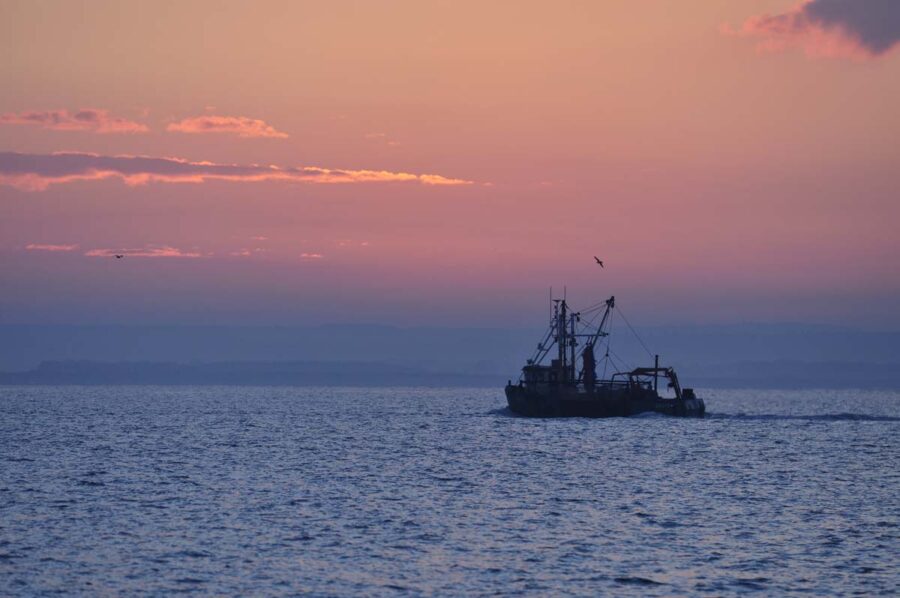Fisheries in the Wash are being squeezed out of existence. John Worrall reports
Once upon a time, life was straightforward. The Wash yielded cockles, mussels and shrimps, which fed birds and the fishing communities at the hearts of Boston and King’s Lynn.

1. Wash shrimpers work on, in the face of continuing ground closures.
The shrimps were trawled, and the mussels and cockles were raked from exposed sandbanks at low tide. It was tricky ground in navigational terms – that shallow embayment swallowed many a ship in the days of sail – but for people and wildlife, it was harmony.
That was still pretty much the case in the late 1970s, long after the advent of engines had made fishing safer and easier. Boats were bigger, but the mechanics were the same – trawling the shrimps, hand-working the cockles and mussels – and it was still regulation-lite, managed by the Eastern Sea Fisheries Joint Committee (ESF), one of 12 such which, for nearly 100 years by then, had administered fishery matters around the English and Welsh coasts.
The first official recognition of the importance of its plants and wildlife came in 1984, when the Wash was designated a Site of Special Scientific Interest, followed, in 1988, by its designation as a Ramsar site, part of the worldwide network of wetlands, particularly those with waterfowl habitat. But none of that immediately affected fishermen. They and the birds were thriving.
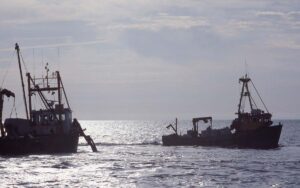
2. From 1986 until 2008, dredgers did most of the cockling, as here in 2003…
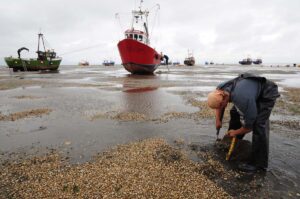
3. … but since then it’s been all hand-worked.
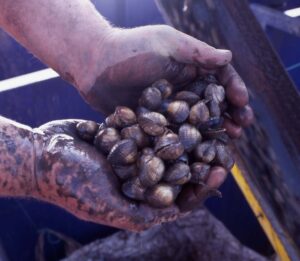
4. Wash cockles.
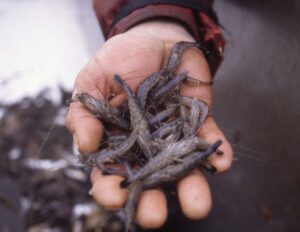
5. The other big Wash fishery is the brown shrimp – actually grey, which is what the Dutch call it…
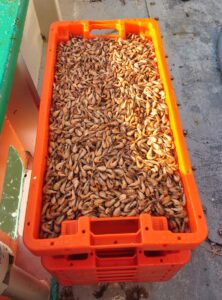
6. … although it’s brown when cooked.
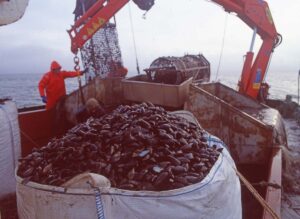
7. Once upon a time, there were also mussels.
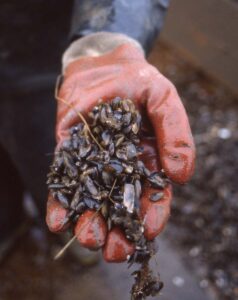
8. Large stocks of seed mussels were a welcome discovery in the late 1990s.
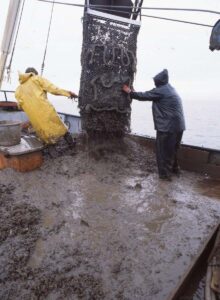
9. The seed mussels were dredged up (lots of mud shows they’re feeding well) and put on deck for taking to the lays…
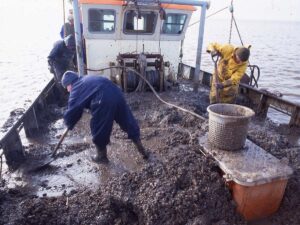
10. … where they were shovelled over the side and then spread out.
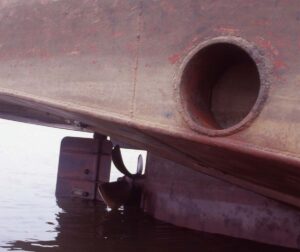
11. Later, seed mussel was imported, and new boats came with a pump-out facility to save all that shovelling.
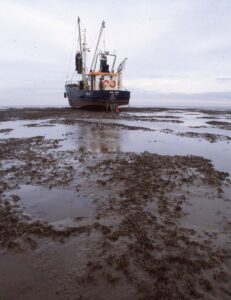
12. The average lay was about six hectares, and because it dried out, was not bothered much by starfish predation.
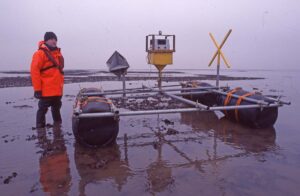
13. Eider ducks descended by the thousand, so sonic bird scarers were trialled…
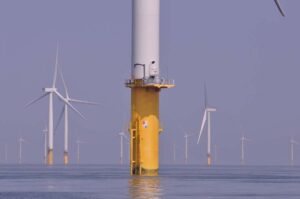
14. … and then wind farms took the ground, and effectively finished the mussel fishery.
Except that in 1986 had come a step-change in fishing efficiency with the start of suction dredging of cockles, each boat sucking up 3t an hour and carrying off 10t. Not all boats did it; dredge gear was heavy and expensive, and smaller boats that couldn’t take it kept on raking. But at that point, no detailed work had been done to quantify Wash shellfish stocks or how much exploitation they might bear. Within a few years, unfettered dredging had had an impact.
And so, in the mid-1990s, MAFF and ESF instituted annual stock surveys and began cockle bed closures. But despite a half-decent spatfall in 1992, and a lesser though still relatively significant one in 1996, stocks continued to fall, prompting closure of the cockle fishery for the whole of 1997. The following year, a TAC was introduced along with a daily boat quota of 8t – but then dredging exhausted the TAC in a few frantic weeks, and it was hard luck on any boat that had a breakdown and missed out on the action. A balance had yet to be struck.
The whole fishery had nevertheless become more formalised, with the advent of the Wash Fishery Order 1992 (WFO), which came into effect in January 1993. It required any boat taking shellfish to have an annual licence, but in order to get one, its owner needed to have an entitlement to a licence, of which there were 128 at the beginning – the qualification being sufficient track record of having fished in the Wash. No more entitlements were issued, and that number has since eroded down to close to 60 today.
The WFO had also created a several fishery, whereby fishermen could lease areas of seabed onto which shellfish – but essentially mussels, because they were the most suited – could be re-laid for growing on. Quite a few lays, averaging about six hectares, had been taken up.
The trouble was that, again by the late 1990s, the mussels had gone the same way as the cockles. Wild stock on the intertidal beds had been hand-worked, but the industry had been dredging sub-littoral stock, which had become very thin, with the overall shellfish depletion – cockles and mussels – having ramifications for overwintering birds and fishermen alike. The mussel fishery had to be closed for a few years. People were leaving the industry.
But then, in the winter of 1997-98, a large quantity of mostly immature sub-littoral mussels was discovered. With the active encouragement of ESF, which was keen to see the industry concentrate more on cultivation than fishing mature wild stock, they were dredged up and put onto the lays. Those lays, on slightly higher ground, were exposed by big tides that deterred starfish – which can otherwise roll in like carpets and consume entire beds – and also barnacle growth, a cosmetic problem for the live trade, and also a financial one, because it reduces the meat-to-weight ratio.
The lays marked a new era for the bulk mussel fishery. Small growers in the North Norfolk creeks had long been cultivating for local markets, doing their own 42-hour depuration before sale to restaurants, fishmongers and consumers, but the bulk live market was for export, particularly to France, where demand from Christmas to the end of the winter was always strong – and the French did their own depuration.
Meanwhile, 1992 had also seen a step-change in nature conservation, with the adoption by the European Community of the Habitats Directive for the conservation of natural habitats and promotion and maintenance of biodiversity. Along with the Birds Directive, initially adopted in 1979 and subsequently revised, it has since formed the basis of European nature conservation policy.
Again, there was no immediate effect on the fishery, because each member state then needed to enact its own habitats regulations to apply the directive’s provisions, and that took a few years to happen.
By the turn of the millennium, the lays were working well, and the industry was soon refining the science by bringing in seed mussels from Ireland and Wales, which was much more expensive than finding them locally – the biggest operators were spending substantial five-figure sums – but a more reliable supply. New-build boats – limited to 14m under WFO regulations – then came with re-laying systems that pumped seed mussels from the hold. This beat the old system of heaping them on deck and simply shovelling them over.
Everything was going swimmingly until the mid-2000s, when eider ducks turned up.
The common eider (Somateria mollissima) is a chunky 3kg sea duck – sort of two mallards stuck together – which is widely distributed in the northern hemisphere and very partial to mussels, diving deep to get them, swallowing them whole and crushing them in its gizzard. It breeds in the Arctic, but winters in large flocks around temperate coasts.
One migration route ran most of the length of the British mainland, before turning left to the mussel-filled Wadden Sea in Holland. But increasing numbers, stopping for a breather in the Wash, discovered mussel-laden lays barely covered at low tide, where they could sometimes feed by simply upending, or even just walking about. Many decided to hang around, each consuming around 2kg a day, at which rate, with several thousand reported to be there at times, they could make big dents in lay stocks over a winter.
There followed a debate between industry and environmentalists about whether this was normal foraging or the equivalent of scrumping from a farmer’s orchard – that stock having been put there at considerable expense.
Sonic bird-scaring devices were trialled, floated on anchored pontoons, and attempts were made to measure their effect. But counting ducks in the wide expanse of the Wash, more particularly in winter mists, was not a precise science, and such movement as was detected was often merely from one lay to another.
But in any case, English Nature, which later became Natural England, wasn’t keen, saying that the birds were part of the site and shouldn’t be disturbed, the argument being that if you put ideal food down, you – or rather, the birds – reaped what you sowed. If the ducks were scared off the lays, they would eat into the wider Wash food stock and deprive other birds. English Nature took it to a public enquiry, and environment secretary David Miliband agreed. Scarers were banned.
The mussel fishery nevertheless laboured on, helped towards the end of the 2000s by the discovery of huge amounts of seed just outside the Wash near Skegness. It was thought to be the result of spat swept out from the lays, and its finding was timely because importing seed was proving too costly, particularly when ducks were eating much of it. However, the first of a number of offshore wind farms was nearing completion just where the seed had been found, which put a stop to further prospecting.
The cockle fishery, meanwhile, was going through further adjustment. In the mid-2000s, the daily boat quota for the dredgers was reduced to 4t, though the dredge fishery was no less frantic, along with a hand-worked fishery working a separate TAC and daily quota of 2t.
But then in 2009, the fleet returned entirely to hand-working, by which time, after a decade of stock surveys and annual TACs, the stock had recovered to reach its second-highest level since records began. At the same time, the still relatively unregulated shrimp fishery was also producing record catches – partly, it seemed, because of the greater volume of shellfish on which to scavenge.
Cockles remain plentiful today – there was another big spatfall this year (Fishing News, 30 July) – although large amounts are sometimes lost through ridging out of mature stock by growing juveniles, and through the still not well understood atypical mortality that can kill them they as reach maturity. The industry constantly contends that when such losses are in train, mostly in summer, it should be allowed to salvage at least some of what will otherwise be lost to man and bird. But the legislation and accompanying precautionary principle mean that procedures for departing from a TAC agreed with Natural England do not allow quick reaction, and there is anyway a conservation view that vulnerable stock should be left, just in case some does survive for overwintering birds.
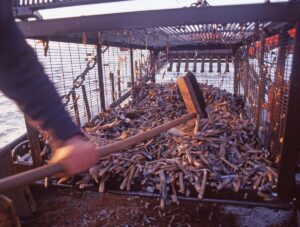
15. There was the possibility of a razors fishery – an invasive species, and plentiful…
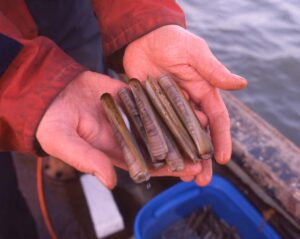
16. … and the right size for canning. But the sums didn’t add up.
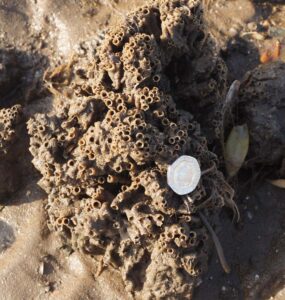
17. Shrimpers who have trawled the Wash for generations are facing ground closures, some of them to protect reefs built by Ross worm Sabellaria spinulosa…

18. … which can be thick enough on the ground to be protected under the Habitats Directive.
There was a time, back in the mid-2000s, when another fishery seemed possible, after a large accumulation of razor fish – estimated by CEFAS at several tens of thousands of tonnes – was found on the eastern side of the Wash.
It was the American species, Ensis directus, which had reached the UK sometime in the 1970s and, as an alien species, was not something about which Natural England was particularly concerned, more especially as it tended to live in mobile sand and silt with few other species present and, conveniently for a fishery, in distinct year classes. Even more conveniently, it was an ideal size for canning. Furthermore, its exploitation would have helped other shellfish because razors filter much more water than cockles or mussels, and therefore eat more. The razor accumulation was thought to be responsible for low cockle meats noted on that side.
In late 2005, a prototype dredge was trialled. It was a bit of a beast, nearly 3m long and weighing around 400kg – which, towed on the beam, could be a handful in any sort of chop, more particularly because it needed to cut evenly into the seabed. But the dredging of a 500m2 trial area yielded nearly half a tonne of live razors, with very little by-catch apart from a few starfish. The fishery could have had a late winter slot – razors are late-spring-spawning – which was a relatively slack period for the wider fishery, or have fitted into early autumn between the main cockle season and the autumn peak for shrimps.
But the price would have been about the same as for cockles – as far as could be ascertained in the absence of an established market – and with a lot more effort involved. The industry couldn’t get enthusiastic.
Meanwhile, on 1 April, 2005, the Wash and North Norfolk Coast was designated a Special Area of Conservation (SAC) under the Habitats Directive, and one particular interest feature, biogenic reefs built by Ross worm (Sabellaria spinulosa) out of sand and seabed detritus (Fishing News, 5 November, 2015), was upgraded from a sub-feature to being a feature in its own right.
That upgrade brought Sabellaria reefs within the definition listed for protection in Annex 1 of the directive, and that in turn attained particular significance after the government produced its Habitats Regulations for England and Wales in 2010.
In August 2012, the government announced its revised approach to the management of commercial fisheries to bring them into compliance with Article 6 of the Habitats Directive, which requires member states to establish necessary conservation measures within SACs for habitats listed in Annex I and species in Annex II.
By then, the 12 fisheries committees around the country had been replaced by 10 IFCAs, whose conservation duties override fishery considerations. In 2013, Eastern IFCA duly introduced a flexible byelaw to enable closure to bottom trawling (and dredging) of areas where Sabellaria reefs were considered at risk. The closures were small to begin with – although fishermen nevertheless pointed out that those grounds had been fished for a long time, and the features were still there. But while it was acknowledged that not enough was known about the direct effect of relatively light shrimp gear, the precautionary principle prevailed.
Sabellaria has since been found to be widespread, and it then comes down to the degree of ‘reefiness’ – whether accumulations are dense enough to constitute a reef. These reefs can rise to 50cm and provide cover for many small organisms – which is their main environmental value – but they accrete and degrade naturally and are mostly sub-littoral, which makes identification and monitoring another less-than-precise science. But again, precaution prevails.
For a while, there was a chance that innovative technology might be shrimping’s saviour, specifically SeeWing (Fishing News, 7 April, 2016), a Dutch trawl system already in widespread use in Holland. This was claimed to keep sufficiently close to the ground due to its inverted aerofoil beam profile – rather than the standard round beam – but with 80% less seabed impact and 15% less drag, and therefore fuel consumption.
A set of kit costing around £15,000 was bought jointly by the two King’s Lynn processing and boat-owning companies, Lynn Shellfish and John Lake Shellfish, for EIFCA to run a comparative test alongside a conventional shrimp trawl.
But although £200,000 of EMFF funding was being lined up, the trial didn’t happen. Large enough areas of listed habitat could not be found – the Wash is a mosaic of different types – and none that were definitively unaffected by previous fishing activity, which could have distorted the results.
And so ground closures have continued, and have now widened to embrace areas of sub-tidal mixed sediments, which are very much associated with brown shrimps – ironically at a time when Wash shrimps have recently attained MSC certification.
And then came the wind farms. By the time those seed mussels were found off Skegness, the adjacent Lynn and Inner Dowsing schemes, with a combined footprint of 20km2 inside the six-mile limit, were already nearing commissioning. Fishermen had opposed them at the planning stage back in 2003.
They were followed by the Lincs wind farm a little further out, which started generating in 2013 on a footprint of 35km2 – equivalent to 5,000 Blundell Parks, the home ground of Grimsby Town FC, as the developer helpfully pointed out.
Their cables, which reached land at Skegness, ran through the SAC, but could do so under Article 6, Paragraph 4 of the Habitats Directive, which provides justification due to ‘imperative reasons of overriding public interest’.
The significance of the schemes from a fishing perspective is that they stand where seed mussels would most likely be found if Wash mussel cultivation was still happening. A report by Stirling University in the 1990s said that Wash gyratory currents meant that for spat generated by lays to be retained in the Wash, lays would ideally be located in the southeastern corner near King’s Lynn. However, a majority were over to the west on the Boston side where the ground was more suited, and where competing razor fish weren’t stunting growth.
Were it not for those wind farms, mussel cultivation could have been self-sustaining through the re-laying of seed from there which, in a pleasing circularity, would in turn have generated spat on the lays to produce successive generations. But the turbines’ rock armour and buried – though potentially exposed – cables have put dredging out of the question.
The fading of the mussel fishery has reduced the overall shellfish biomass and, with it, the birds’ feeding options, and it’s now unlikely to revive, not only because of the cost and practicalities of acquiring seed, but because absence from a market breaks contacts. Buyers have found other suppliers, so the industry would need to find new ones from a standing start.
Wind farm development has since gathered pace, and EIFCA’s area will be the most affected in terms of export cables cutting through protected habitats. There are already eight operational farms, five more under construction, and a further eight planned but not yet consented.
They include Hornsea Three with turbines spread over 695km2, 121km off northeast Norfolk’s coast. Its cables would run through an area closed to towed fishing gear to protect sub-tidal mixed sediments, making landfall at Weybourne in North Norfolk. The planning decision has been delayed until 31 December.
Another is the already consented Norfolk Vanguard, with a 590km2 footprint 47km out, with cables to run through an area closed to protect Sabellaria reefs before landing at Happisburgh in northeast Norfolk.
The government now requires developers to take compensatory measures for damage they cause to habitats, and these two have been in discussion with EIFCA to explore the options.
The developer of Hornsea Three, Orsted, has suggested work to regenerate mussel beds in the Wash, and the removal of fishing gear debris to reduce ghost fishing – fair enough, if somewhat after the event for the mussels.
But the developer of Norfolk Vanguard, Vattenfall, has suggested that EIFCA could close further areas to fishing – on the basis that if fishing can damage SAC features, such closures would compensate for damage that Vattenfall would be doing. That suggestion was delivered with the apparent assumption that the fishing industry would be supportive.
Having hopefully first established that Vattenfall was actually being serious, EIFCA pointed out that it does not have powers to close grounds to offset damage caused by non-fishing activities – and, more particularly, that it wouldn’t under any circumstances consider penalising the inshore fishery for environmental damage caused by the offshore renewables industry.
And still the fishery labours on. EIFCA is currently carrying out a mussel survey that will probably be completed at the end of October, but industry interest will be limited to what the results say about the overall shellfish biomass, and the ramifications for the cockle fishery against bird food requirements. In any case, seed finds will probably soon be irrelevant with the expiry, in early January 2023, of the 30-year WFO which established the lays; its replacement is likely to be something different.
But cockle stocks have regained buoyancy, now that the mistake of unfettered dredging is well in the past, while MSC certification for the shrimp fishery speaks for itself. A broad equilibrium between biomass, birds and the industry has been restored. With close monitoring and management by EIFCA, if it is adequately resourced, this can be maintained.
Nevertheless, with shrimp ground closures having moved on to embrace those areas of sub-tidal mixed sediments, industry decline in the Wash can only continue. There are four rivers feeding into its 62,000ha embayment, and with the churning currents therein – the clue is in the name – it’s a fair bet that mixed sediments are to be found all over the place. Strap on the all-embracing and all-rebutting precautionary principle, and the fishery becomes governed by what-ifs rather than survey numbers.
This is not all EIFCA’s doing; it can only apply the legislation and manage the fishery on advice from Natural England – although for ‘advice’, read ‘instruction’, watched closely by NGOs whose agendas are not at all concerned with fishing or its socio-economic benefits, and probably just want it gone. As matters stand, the legislation could allow them to push progressively to that end.
It has been said that if EIFCA closed the whole of the Wash to fishing, it would meet all the conservation objectives. That is not a stated policy, but with those increasing ground closures under the absolute primacy of environmental considerations, that is very much the direction of travel.
So things have got to the stage where a political debate is needed on whether, in a patch of coastal water with all the environmental designations of the Wash, fishing is to be permitted at all in the long term. Nature and fishing are back in harmony, but tightening application of the legislation is strangling the industry.
Come 1 January, legislative power on this will – or at least should – be back in the UK government’s hands, at which point all concerned can lobby MPs. This may or may not change much, but at least there will be more chance of leverage than there ever was with MEPs.

